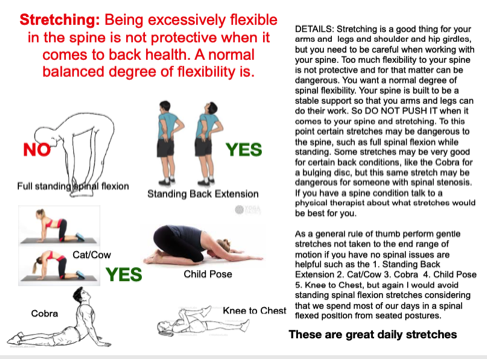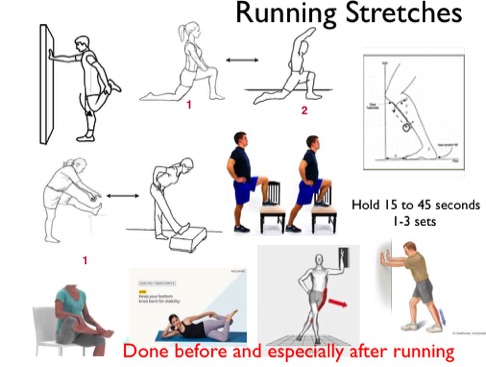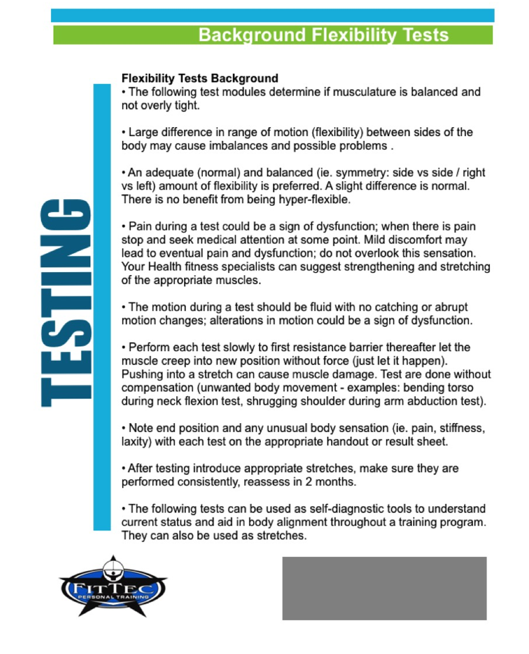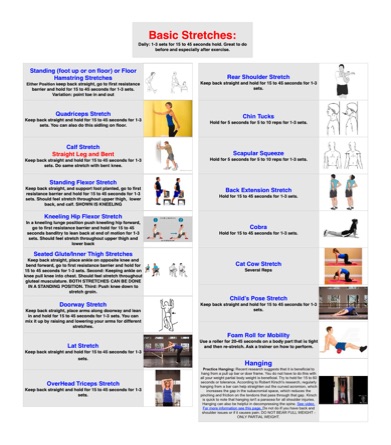Stretching, Mobility, Movement Information Page
WELCOME TO OUR MOBILITY INFORMATION PAGE
Stretching, mobility exercise, and joint care is a big part of our programming. Use this page to gain a further knowledge of stretching and mobility exercise and how to perform them properly.
Key Point:
Healthy muscles and joints should have have a balance between flexibility and strength. We suggest seeking a normal to better than average amount of flexibility versus being hyper or hypo flexible in most cases. Overly flexible muscles without adequate strength will not be able to support joints when they come under stress, thus predisposing one to joint injuries and arthritic changes. On the other hand overly tight muscles may limit the range of motion of a joint, which require a degree of range of motion for nourishment and good joint health. So it is best do have an adequate and balanced amount of flexibility.
Stretching 101
Adapted from ACSM and NHS.
WHAT IS FLEXIBILITY? Simple answer the available range of motion around the joint, which is improved with stretching. There is no benefit from being hyper-flexible. A normal, balanced (side for side), and pain free range of motion is preferred.
1. Is there any benefits?
Absolutely, so much so that it is a fitness tenet. There is no great benefit from being hyperflexible though. You want a normal amount of flexibility throughout your body that is balanced from side to side (ie your right side should be similar to your left). Also, when doing a stretch your muscles and joints should not be painful. Pain is a sign of dysfunction. Bottomline: Normal range of motion assures good joint health. There are some that support the thought that there is no benefit from stretching to that I say briefly: What is one of the first thing that you done in therapy after an injury (stretching). See Key Points section.
2. What is the best time to stretch?
Many say you should stretch only after exercise or not at all. Believe me stretching is a good thing to do all the time. Stretching before exercise tells you if there is something tight or not right with your body. After exercise helps you reset your body and aids in recovery (see details below). I suggest to people to do stretch all day long, but do not push it, juste ase into it.
3. How to do it?
You can stretch in a variety of ways and positions. It is almost endless. There is although a wrong way to do it. Never go into a stretch hard or fast or forcefully. Ease into it. I always tell people to go into the first resistance barrier and hold and let things happen from there. How long you do it is dependent on the type. Static is held for 15 to 60 or more seconds. Other types have different time lengths. Typically 1 to 3 sets are done for static stretches.
Types
Static stretching
Stretch a specific muscle until you feel tension and then hold the position for 15 to 60 seconds. This is considered the safest way to stretch — done gently, it allows muscles and connective tissue time to “reset” the stretch reflex.
Active isolated (AI) stretching
Stretch a specific muscle until you feel tension, and then hold the position for just one or two seconds - some use the phrase pressure on pressure off others use the phrase stretch on stretch off. Do several repetitions. I particularly like this form of stretching.
Proprioceptive neuromuscular facilitation (PNF) stretching
Contract a muscle, release it, and then stretch. This can be done with the assistance of a partner who helps with the stretch. It can also be dangerous if done improperly. Pursue it only under the supervision of a physical therapist or trainer.
Dynamic stretching
Dynamic stretches are active movements where joints and muscles go through a full range of motion like lunges, arm rotations, leg circles, etc. They can be used to help warm up your body before exercising. Dynamic stretches can be functional and mimic the movement of the activity or sport you're about to perform
Ballistic stretching
Fast movement stretches where force is put into or bouncing is part of the stretch is not good for anyone.
4. What are the recommendations from the ACSM?
The American College of Sports Medicine (ACSM) recommends that adults should do flexibility exercises at least two or three days each week to improve range of motion. Each stretch should be held for 10 to 30 seconds, to the point of tightness or slight discomfort. Repeat each stretch two to four times, accumulating 60 seconds per stretch. For older individuals, holding a stretch for 30 to 60 seconds is recommended for the greatest benefits. You should stretch the muscle enough to feel a light to moderate discomfort, but don’t go too far where you start to feel pain. Listen to your body. Many, including myself, believe tight areas should be stretched daily, since the affects of stretching is short lived.
5. How should I warm up?
The purpose of warming up is to prepare mentally and physically for your chosen activity. A typical warm up will take at least 10 minutes and involve light aerobic movements and some dynamic stretching that mimics the movements of the activity you're about to perform.This process will raise your heart rate and increase the blood flow to your muscles, thereby warming them up. There is suggestion that a warm up also activates the nerve signals to your muscles, which results in faster reaction times.
6. Should I stretch before exercising?
Your decision to stretch or not to stretch should be based on what you want to achieve. To reduce injury, stretching before exercise is not helpful. Time better spent by warming up your muscles with light aerobic movements and gradually increasing their intensity. If your objective is to increase your range of motion or if you are doing a sport/exercise like dance or gymnastics or figure skating then you should stretch. Stretching before exercise will not show a noticeable decrement in most exercisers. I like using it with clients to help them understand their body and if there are possible issues in a range of motion. Sometimes you do not know if a problem exists unless you take a muscle a range of motion. It is also important in restoring balance and good posture across the body through doing daily stretches.
7. Should I stretch after exercising?
The best time to stretch is when the muscles are warm and pliable. This could be during a class or after exercising. Stretching may also help signal if you did too much during exercise.
8. Does Foam Rolling Work?
It certainy does. It can actually be better than stretching ( see more here ).
More Detailed Questions for those who want to know more.
What happens when we stretch?
Regular stretching is thought to increase flexibility, both by making muscles more supple and by retraining the nervous system to tolerate stretching further. Flexibility from regular stretching gradually disappears once you stop stretching – some say within weeks and others within hours therefore it is typically recommended that you stretch daily or most days of the week. It is unclear what happens from a stretch it could be due to physical changes in the muscles that control those joints, or just a greater tolerance to stretching or a combination of them both.
How much flexibility do I need?
It highly depends on your activity. I tell people that you should try to have a normal and balanced amount of flexibility. In other words your right side should be the same as your left and that you should not try to achieve hyper-mobility because there is some suggestion that it may lead to instability. In fact Stuart McGill, a leader in back care, and many renowned physical therapist do not recommend a high degree of flexibility to the spine. Their rationale is that joints need a degree of stability, especially the spine. Also there is a difference in sport and job demands. The flexibility demands of a gymnast or a ballet dancer are clearly different to those of a runner. I feel the most important is to have both sides of your body to be the same in terms of flexibility. Second you should try to possess enough flexibility that you have proper posture and movement patterns. Example if you have rounded shoulders then your pectoral muscles including the subscapularis should be stretched. If you have a very tight gastrocsoleus group it would be prudent to increase it to where it was normal so that it would not interfere with running or squatting mechanics. This does not mean that the group has to be hyperflexible it should possess a normal amount of motion.
Stretching Controversies
Does stretching decrease strength?
Although static stretching is part of some pre-exercise or sport routines, some research like a study in 2013 indicated that it weakens muscles. That is why many recommend active dynamic warm-up before exercise in place of static stretching in some power and sprint athletes right before the event. But I do recommend that they do as well as everyone some static stretching at other points in their training. The authors of this type of research suggest that to generate power during exercise the muscles and tendons store and release energy like a spring. Too much flexibility may reduce the muscle's natural spring, which may be detrimental for activities involving running, jumping and sudden changes in direction, such as running, football or basketball. However, too little flexibility may increase the risk of muscle strain injury, as the muscles are unable to lengthen and absorb this energy. Other studies suggest that the impact of static stretching on strength and power are short lived. If worried about performance perform dynamic warm ups before your sport and static stretches not to the extreme after. Again, most sports require a normal degree of range of motion. A lead author on one of the largest reviews on pre-performance stretching, believes the reduction in performance from pre-exercise stretching has been overstated. "It is likely that durations of stretch used in the warm-up routines of most recreational exercisers produce negligible and transient reductions in strength," he says. I agree with his point.
Does stretching before exercising reduce the risk of injury?
There is some evidence that suggests that pre-exercise stretching does not reduce the risk of injury. Professor Rob Herbert, Senior Principal Researcher Fellow with Neuroscience Research Australia, took part in the 3 largest randomized trials on the effects of stretching. They all concluded that stretching had little or no beneficial effect on reduction in injury risk. The most recent and largest of the three studies found "a hint" of an effect on reducing injuries like ligament tears, muscle tears, strains and sprains. But Prof Herbert cautioned, "If stretching does cut your odds of one of these types of injuries, it's by only a very small amount.” That being said it would be prudent to stretch areas to within normal lengths in your body for possible injury prevention but more so for balanced posture and pain reduction.
Does stretching reduce soreness?
There is no evidence that stretching helps to reduce or prevent a type of pain that can show up a day or two after exercising – also called delayed onset muscle soreness (DOMS).
A 2011 review by Prof Herbert found that "muscle stretching, whether conducted before, after, or before and after exercise, does not produce clinically important reductions in delayed onset muscle soreness in healthy adults”. DOMS is different from tight and sore muscles. There is very much clinical evidence that stretching does produce an analgesic effect in muscles that are tight and sore. Even though the effect is short lived its effects is often warranted by many.
Stretching Dos and Don'ts
• Do go to the first resistance barrier and hold. Let the stretch happen. Hold for 15 to 30 seconds or more (60 seconds) if area is very tight.
• Do listen to your body and stretch where you are tight as well as where you are not. Use it as a way to understand your body.
• Do stretch chronically tight areas — your fingers, pecs, biceps, quadriceps, hamstrings, hip flexors, and calves .
• Do maintain what’s known as a “general stretching program”: Stretch for at least 10 minutes, at least three times per week.
• Do consult a professional to assess chronic overuse patterns and an areas that are painful that may require assessment.
• Don’t do ballistic or forceful stretching, the kind that involve bouncing or jerky movements or momentum.
• Don’t force a stretch. Find the first resistance barrier and then gently breathe into the stretch or just let it happen until your body relaxes.
• Don’t twist or flex your spine hard especially through the lower back and neck, since it can put pressure on discs.
• Don’t hold your breath when you stretch. Long, slow breathing encourages your body to relax.
• Just let the stretch happen
adapted from K. Walsh, ACSM, and ACE
Stretching and Flexibility
Details for those who want to know more by Chris Morin:
• Increasing flexibility through stretching is one of the basic tenets of physical fitness and physical therapy.
• Stretching improves flexibility, which increases the ability of a joint to move through its full range of motion.
• In order to restore function to a muscle after injury mobility therapy starts before strength and movement programming.
• There is a conception that a fit body is highly flexible body though research suggests that it is better to have a balanced amount of flexibility.
• One of the reasons for this is that low back pain disorders have been found more in people who have flexible spines than those who do not. Some joints that are hyper-mobile lack stability and therefore are more prone to injury. On the other hand those who have movement disorders have tighten muscles preventing proper motion.
• Many pain disorders and postural issues usually accompanies some lack of flexibility in an area with an accompanying weakness.
• Therefore some physical therapists and trainers suggest stretching muscles of the neck, knees, ankles and hip and shoulder girdles to their end range while being gentler with the spine. Some even suggest to avoid the ever popular touch your toes and windmill stretches.
• Some activities, such as gymnastics and dance, require more flexibility than others, such as running. Therefore stretch training is sport specific.
• Training for hyper flexibility may decrease performance in some sports. Distance runners were found to have decreased running economy from a stretching program of the calf region.
• Stretching has been found to decrease strength before a maximum effort, though the effects have been found to be short lived. It would be prudent for a strength and power athletes to abstain from static stretching before an event rather they should do dynamic warm up motions like arm swings and marching. These athletes should do static stretching after training but to a point where there is a normal amount of flexibility. The reason for not abstaining is that research has should that lack of calf flexibility is linked with improper squat performance which may lead to injury since a squat motion is involved with so many sports. The same can be true about rotator cuff injuries and the lack of shoulder mobility.
• One consistent thought throughout the fitness community is to warm up through large body through large motions, some call it dynamic stretching, rather than doing traditional static stretches before sport and working out. Another consistent thought is static stretching should be done after exercise or sport activity.
• Some people are naturally more flexible. Flexibility is primarily due to one’s genetics, gender, age, body shape and level of physical activity. As people grow older, they tend to lose flexibility, usually as a result of inactivity, but partially because of the aging process itself. The less active you are, the less flexible you are likely to be. As with cardiovascular endurance and muscle strength, flexibility will improve with regular training.
• When rehabbing an injury or when trying to correct movement or postural problems stretching usually occurs before strengthening.
• All of these key points lead to the conclusion that stretching is important. It creates balance across the body and not hyper-flexibility in most cases. It would be prudent for most to have their range of motion as well as posture assessed to determine where there is a lack of flexibility and possible weakness.
Foam Roller and Mobility
It is a popular form of self-therapy among health and fitness pros. It really works. If you’ve experienced physical trauma, scarring or inflammation, your fascia may have lost some of its elasticity and become tight, restricted, and a source of pain. Rolling might alleviate this sensation for a time. It is also used as a warm-up for mobility and/or a cool-down for recovery, although it should not replace stretching and mobility exercises. Foam rollers come in many shapes, sizes and firmness. One study found no difference in outcomes from different rollers. It is a personal preference. Find out what works best for you. Most people can use it safely ( see more here ).
Stretching Exercise Videos
Lower body stretches video before and after running, walking, or exercise
Lower back stretches video standing and seated
Stretching and Mobility Research
Stretching before a run does not necessarily prevent injury, study finds
https://www.sciencedaily.com/releases/2011/02/110218083422.htm
Feb 20, 2011 ... Stretching before a run neither prevents nor causes injury, according to a new study. However, runners who typically stretch as part of their ...
Stretching seems to do the trick plantarfascitis -- ScienceDaily
https://www.sciencedaily.com/releases/2010/11/101104101657.htm
Nov 4, 2010 ... Patients with acute plantar fasciitis who perform manual plantar fasciitis stretching exercises, as opposed to shockwave therapy, had superior ...
Stretching out Does Not Prevent Soreness After Exercise ...S
https://www.sciencedaily.com/releases/2007/10/071016195932.htm
Oct 17, 2007 ... Studies show that stretching before or after exercise has little or no effect on muscle soreness between half a day and three days later.
Yoga and stretching exercises beneficial for chronic low back pain ...Y
https://www.sciencedaily.com/releases/2011/10/111024164710.htm
Oct 24, 2011 ... Yoga classes were found to be more effective than a self-care book for patients with chronic low back pain at reducing symptoms and improving ...
Getting the Most from Your Stretching Routine
Dec. 8, 2015 — The conclusions of a systematic review of hundreds of studies contradict the most common static stretching findings from the last 15 years. This research reviews hundreds of studies to determine best ...
Stretching and Flexibility
Exercise Modules-Great List of Stretches
See range of motion self tests at this link See Self Test Page) or watch the video below. If you find yourself tight in an area please seek out our professional guidance on how to stretch properly or see flexibility exercises below (Flexibility Exercise Page). Want basic stretches (see basic stretches page).
Pain is an important sign as you go through these tests. It could be an indicator of dysfunction. If you have pain you should seek out professional help.
Are You Tight?
Self Flexibility Tests

These are some of my Favorite Low Back Stretches

These are some of my Favorite Running and Workout Lower Body Stretches


